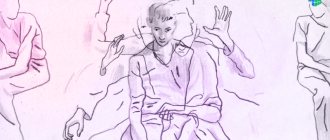Remember Pavlov's series of experiments to study conditioned reflex reactions associated with the functioning of the digestive system? Ivan Petrovich was not the only scientist who conducted experiments on dogs in order to discover new knowledge. We will talk below about how small friends have served people as a means of obtaining important psychological discoveries.
Imagine teenager Nikita. This young man is interested in clay modeling, has been doing it for a year now, and finally he decides to purchase a potter's wheel in order to make crafts on his own and, perhaps, earn money by selling them. But here Nikita’s mother comes into play, who, having heard about her son’s idea, says: “Why do you need this pottery wheel? In order to make real crafts from clay, you need to have high skill and practice for more than one year, otherwise no one will be interested in your crafts. Let’s better take a few more lessons, and then maybe you’ll go to drawing...”
Nikita, having thought about her mother’s words in a slightly demotivated mood, agrees with her idea and continues to go to sculpting. Time passes, but then, to the misfortune of the parent, another idea of Nikita comes.
“Mom, what if I cook breakfast myself? I get up early, and yesterday my sister and I decided to cook scrambled eggs... It turned out very tasty, and I liked it!” At the moment of uttering the last phrase, the mother is already replaying in her head a picture of her son running around in her kitchen, collecting fragments of a broken plate, leaving an unwashed frying pan, wiping a cabinet with spilled yolks with a hand towel... Of course, she decides to persuade Nikita to leave this stupid idea – there is no need for a man to hang around in the kitchen (especially one that belongs to his mother). “This is a woman’s business,” the parent snaps, and Nikita, having again experienced demotivation bordering on immense masculinity, does not touch the dishes and food except for the moments of devouring the latter.
Do you think your mother chose the right parenting methods? What kind of man will Nikita make if the words of another person (even the most important woman in his life) several times became an obstacle for him on the path to realizing his ideas - pleasant to him and initiated by him? Most likely, you will agree that Nikita, instead of realizing his plans, will begin to expect the finished results of other people’s work, and will move from the mode of activity to passivity.
Of course, not all young people are prone to loss of initiative. There are also those who, despite the persuasion of other people, adhere to their positions and plans, and such people are definitely lucky. But what should those who can be dependent on others to a fairly large extent do? It turns out that this condition is considered a major psychological problem. Moreover, a considerable number of people live with her, often without even knowing it.
Psychological problems are by no means a trifle for every individual, and in order to gain greater confidence in your mental health, we advise you to complete our online program “Mental Self-Regulation”, where in just 6 weeks you will learn to analyze your behavior and be more conscious in your approach to personal problems, get rid of stress and apathy, conquer many fears.
Returning to Nikita, let's imagine a little and assume that as a child the young man had a dog named Dolph. Taking a break from Nikita's storyline, let's turn to the story of his pet and begin our own story about learned helplessness syndrome.
How it all began?
Meet: the person who borrowed Dolph from Nikita is Martin Seligman, psychologist, founder of positive psychology. Today, Seligman is the director of the Center for Positive Psychology at the University of Pennsylvania in Philadelphia, where, in fact, in 1967 he conducted experiments with dogs.
The study consisted of two stages. Let's briefly describe each of them.
Stage one
There were three groups of dogs in total. The first group was placed in a cage with a lever. The dogs were wearing a harness that conducted electricity. Thus, the animals were exposed to small electrical discharges (quite a sad story). However, the dogs had the opportunity to stop the flow of current by engaging the lever. By switching it to the opposite mode, the subjects were able to exit the cage.
The second group of dogs was also placed in a cage with a lever. A small amount of current was transmitted through the harness in the same way, but these dogs could not leave the cage following the example of the dogs from the first group, i.e. their actions with the lever were meaningless, and attempts to change its mode were futile. The cessation of the current supply depended solely on the actions of the dogs of the first group - if they managed to open the exit, then the second group of dogs also received freedom from “torture”.
The third group of dogs (which included Dolph) did not experience any discomfort at all. Fortunately, no current was supplied, and the animals simply stayed in the cage for some time, and after the time had passed they were freed. This was the control group [L. Pervin, O. John, 2001].
Based on the first stage, the following conclusions were made :
- dogs from the first group quickly figured out the principle of how current flow works and were able to understand that the position of the lever directly affects their torment;
- The dogs of the second group showed behavior close to despair - they whined and howled in anticipation of the current ending and release.
Then the next stage of the experiment was carried out.
Stage two
Experiments with the supply of current were not completed for dogs. The animals were placed in a new cage, divided into two compartments using a partition. A small amount of current was supplied to half the floor of the cage (before the partition), which caused discomfort to the animals, while the second half of the cage (after the partition) was safe. Accordingly, in order to get rid of the pain, the dogs had to jump over the partition.
Based on the results of the second stage, it turned out that the dogs from the first group tried to find a way to get rid of pain and eventually jumped over the partition, finding a safe territory. The dogs from the second group lay on the electric floor and whined, waiting for rescue and not even paying attention to the partition. And the dogs from the third group continued to sit in the cage, into which no current was supplied at all (Dolph, apparently, is lucky).
The results of the experiment turned out to be very informative and allowed Martin Seligman to discover the doctrine of learned helplessness [B. Overmier, M. Seligman, 1967].
If we analyze the behavior of dogs, it becomes clear that the animals, having once experienced the negative experience of their helplessness, realizing that their actions did not lead to anything productive, despaired, and with a new crisis situation they did not even try to correct it.
An individual's behavior based on the idea that his actions will not lead to any results is called learned helplessness. Returning to Nikita, we can now say with confidence and scientific validity that mother was wrong, because a young man must implement his plans, strive to implement his ideas and see their results - negative or positive, in fact, it does not matter. The main thing is that his actions will bear fruit, judging by which he will need to further build a strategy for his actions.
However, the series of experiments on learned helplessness did not end there.
Treatment for children and adults
Important! Although learned helplessness can be difficult to overcome, there are ways to combat it.
One potential treatment based on neuroscience research is the connection between the ventromedial prefrontal cortex (a part of the brain that plays a role in suppressing emotional responses) and the dorsal raphe nucleus (a part of the brain stem associated with serotonin and depression) and learned helplessness.
This potential treatment could be aimed at stimulating the ventromedial prefrontal cortex and inhibiting the dorsal raphe nucleus through medications, electrical stimulation, transmagnetic stimulation, or psychologically through therapy.
In particular, recent studies have shown that transmagnetic stimulation (TMS) is quite effective in treating depression . Given the link between learned helplessness and depression, it makes sense to think that treating one might be an effective treatment for the other.
Speaking of effective treatments for depression, therapy is also a good choice for people struggling with learned helplessness. Those who feel helpless may benefit from working with a mental health professional to explore the reasons for their helplessness, replace old and harmful beliefs with new and healthier beliefs, and develop a sense of self- compassion .
A study conducted by psychologist Carol Dweck (the researcher who proposed the growth versus fixed mindset ) found that there is another extremely effective way to alleviate learned helplessness: through failure.
In Dweck's 1975 study on the subject, participants (all of whom were experiencing an extreme reaction to failure) were divided into two groups: one received intensive training in which they did not perform their tasks, and they were instructed to take responsibility for their failure and attributing it to a lack of effort while the other group underwent intensive training. The results showed that the group that received training alone showed no improvement in their extreme reactions to failure, while the group that received failure showed a marked improvement.
Important! This experiment was one of several studies conducted in the 1970s, 1980s, and 1990s that laid the foundation for a new theory of human behavior related to failure, learned helplessness, and resilience .
From dogs to people
11 years later, psychologists E. Langer and J. Roden continued research into learned helplessness, but this time the object of the experiment was the behavior of elderly people in a nursing home.
The group of participants included two floors with elderly people:
- second floor (9 men and 35 women);
- fourth floor (8 men and 39 women).
So, according to the instructions of the researchers, the administration held two meetings with residents of the corresponding floors. Those located on the second floor were assured of complete safety and comfortable conditions. In fact, the administration's message was that older people do not have to worry about anything, all organizational issues have been resolved for them and they have nothing to worry about. Those located on the fourth floor were asked to be more responsible for their stay in the establishment. The participants in this group had to decide for themselves what to eat for lunch, when and what movie to watch, how to spend their leisure time, how to arrange their life, etc.
As can be seen, the main difference between the groups was the degree of dependence on the decisions of the management of the nursing home (as with the dogs, who depended either on their own actions with the lever or on the actions of their “colleagues”). Thus, the elderly were monitored for three weeks, tracking not only satisfaction with their lives, but also activity, the need for communication, nutrition, and patient habits.
The results of the study were assessed based on the level of happiness. Thus, in the first group of patients (second floor) a negative value of this indicator was observed, equal to -0.12. On the contrary, the second group of patients (fourth floor) showed the opposite result: +0.28. According to the nurses who worked in the nursing home and observed the subjects, the condition of the patients changed in the same direction. In the first group, a greater desire and need for communication was noticed, while in the second, older people strived more for passive observation of staff [J. Rodin, E. Langer, 1978].
These results supported Martin Seligman's theory of learned helplessness.
However, it is important to understand the significance of this experiment in the context of learned helplessness specifically in older populations. We often believe that our elders are not capable of fully organizing their lives, leisure time, and coping with tasks that they were once capable of, and this is certainly true. But you shouldn’t focus on this.
It turns out that memory deterioration, a decrease in cognitive abilities, and general body tone are aggravated when the elderly lose the ability to control their lives, and this directly develops the syndrome of learned helplessness. If such groups of the population are given greater opportunity to change some aspects of their lives, and given the opportunity to make decisions on their own, then the development of learned helplessness can be prevented.
However, we will mention how to get rid of learned helplessness syndrome a little later. Now let’s briefly look at another experiment, conducted on young groups of the population.
Seligman's model of optimism
Seligman, one of the researchers who helped discover the phenomenon of learned helplessness, later found his attention drawn to what may be the exact opposite of learned helplessness: optimism .
Although Seligman's name had been synonymous with learned helplessness for many years, he knew he had much more to offer the world. His work on this topic led him to think about what other perspectives could be learned and whether people could develop positive traits rather than developing feelings of helplessness.
Seligman's research led him to create a model of learned optimism. He found that through resilience training, people can learn to develop a more optimistic outlook. This ability has been observed in children, teachers, military personnel and many others.
It may not be as easy to learn optimism as it is to learn helplessness, but it can be done . If you want to learn more about optimism and how you can learn it, check out Seligman's book, Learned Optimism: How to Transform Your Mind and Your Life . In addition to a brief overview of the research on the subject, you'll also read about several simple techniques you can use to develop a more positive and compassionate explanatory style .
Experiment with noise
This study was carried out in 1975 by Martin Seligman, already familiar to us, and his colleague Donald Hiroto. The subjects, this time college students, were divided into three groups. The first two groups heard an unpleasant noise at the first stage of the experiment, while the third group of participants heard nothing. Again, the first two groups were divided according to the following principle:
- when noise occurred, participants in the first group had the opportunity to press a button and prevent sounds from coming in;
- When noise occurred, participants in the second group did not have the opportunity to influence the cessation of sounds.
At the second stage of the experiment, the students again found themselves in a noisy environment, but now, when a light signal appeared, they could turn off the incoming sounds independently by moving their hands from one side of the box to the other. As you might have guessed, the first and third groups of students quickly completed the task, but difficulties arose in the second group - they sat passively and waited for the noise to stop on its own [D. Hiroto, M. Seligman, 1975].
So, three experiments showing the effect of learned helplessness served as a great impetus to start paying attention to this problem, looking at it from different angles. Let's now look at the reasons for the appearance of this painful phenomenon.
Causes of learned helplessness
Learned helplessness does not happen on its own. Of course, some people are more prone to developing this syndrome than others, but there are certain objective sources of its occurrence. Here are some of them:
- Uncontrollable events. Very often, these events occur in childhood, when the foundation of social interaction patterns is laid in the child. For example, if your parents raise you according to the principle “don’t stick your neck out where you shouldn’t” or “know your place” or “don’t be so active”, this will develop in you the position of a conformist who does not want to take initiative and generate any those are bold ideas. Alas, it is precisely people with opposite qualities in our time who claim at least average social status, namely the brave and creative.
- Overprotection. And not only from the parents. Any concern for you, any action performed in your place, provided that you can do it yourself, leads to the effect of excessive care - learned helplessness. If in a dorm room you come across a helpful comrade who cleans the room, cooks dinner, and washes your clothes at the same time, then you are guaranteed mutual dependence (you are satisfied with the results of his work, and he is satisfied with your pleasure).
- Internal personality qualities. The fact is that for some people, the mistakes they make seem fatal. Depression and anxiety immediately overwhelm such people; they stop dreaming of new achievements, become isolated in their failures, and lose faith in themselves and their strengths. Of course, such people have a more difficult time than inveterate optimists [Now You Know, 2020].
Remember Nikita, our hero from the beginning of the article. This young man, on the one hand, succumbed to his mother’s excessive care, on the other, the qualities of his personality could not allow him to resist and show character. However, the most important factor that unites all the above reasons is the lack of control, with only one amendment: let's not confuse the imaginary lack of control with the real one.
If you are a confirmed bachelor who is not in demand among girls, because... There were a couple of precedents of failure, this does not mean that you are not in control of the situation. Yes, a lot in this matter depends on the girls’ behavior, but let’s be honest: finding a partner is a rather complicated thing and with a large share of luck. Finding a person who understands you and accepts all your shortcomings is problematic, and you need to make efforts for this. It is the latter circumstance that often prevents one from getting rid of the position of learned helplessness.
Start paying attention to your appearance, go to places where you can meet decent girls, invest in yourself - be an interesting person. This is called “situation control”. Isn't this something that most men can do? Stop thinking in terms of “I can’t.”
We hope that you have thoroughly understood the causes of learned helplessness. If you find yourself in the descriptions above, it’s time to pay attention to ways to get rid of this syndrome.
What could be the cause of helplessness?
Learned helplessness is, unsurprisingly, associated with many negative characteristics, including:
- Age: The older a person is, the more likely they are to change or lose their roles.
- Especially the stress associated with poverty.
- Anxiety and worry , especially regarding tests for students.
- Greater negative response to expected pain.
Not only is learned helplessness often associated with other negative conditions, but it also causes a variety of negative consequences, including:
- Negative symptoms, as well as negative emotions about the disease.
- Maladaptive perfectionism.
- Burnout or emotional exhaustion and cynicism.
- Worsening depression, anxiety, phobias, shyness and loneliness in those already suffering.
How to overcome learned helplessness?
Continuing the theme of the bachelor, we have actually already said that real actions need to be taken. Nevertheless, before real actions you need to come to awareness, therefore:
Tip #1. Be aware
Until you begin to analyze your behavior, until life seems boring and full of problems to you, until you understand that your reality is filled with dependence on the actions of other people - your family, friends, colleagues, etc. – in any area, do not expect to overcome learned helplessness.
This is quite easy to understand. Ask yourself: How many aspects of my life depend on other people? What happens if people close to me stop communicating with me? How often do I seek the services of outsiders?” If the answers to these questions are positive, you should think about whether you have suffered from the phenomenon of learned helplessness.
Nikita from our story, due to his age, does not have deep life wisdom, but as time passes, it will be great if he thinks about the influence his mother has on making decisions concerning his life.
Mindfulness is one facet of the ability to reason logically and effectively. To master these skills, take our online Cognitive Science program, where you will learn more than 20 thinking techniques in 2 months. Interesting 15-20 minute lessons will help you make effective decisions and understand the peculiarities of thinking. And we proceed to the second recommendation.
Tip #2. Take back control
It’s great if you figured out the problem. Having again mentioned the main cause of learned helplessness - lack of control - it would be logical to recommend introducing it.
Don't expect that you will immediately begin to control all aspects of your life. Start small. Set aside a small amount of time to do things that you would normally delegate to someone else. You can sit down and think of ways to make it more interesting.
Nikita, who wanted to cook breakfast, can finally try to participate in this process. One morning, for example, when mom is busy in the kitchen, the guy can help her wash and cut some food or put away the dishes. At the same time, mom will understand that Nikita and the kitchen are not equivalent to a disaster. Undoubtedly, the moment will come when mom will wake up to the smell of freshly prepared baked goods coming from the kitchen.
Tip #3. Celebrate small victories
Of course, when we want to fix something, we need everything at once. But that doesn't happen. However, the most important thing is not to lose faith.
Understand: if you have taken the path of correction, that’s already great. If you have achieved a result, but it is too little, it is insignificant - rejoice, because before that you did nothing at all for a long time. Every insignificant step is already moving forward.
Another problem here can be comparing yourself to others. We warn you in advance: you shouldn’t do this. Learned helplessness is a problem that concerns you personally, so track your results, you don’t need to follow the success stories of other people.
Nikita, if you remember, also wanted to sculpt clay crafts and make money from it. Of course, it is not a fact that success would have awaited the young man from the very beginning of his creative career, because to some extent, his mother was right when she said that selling clay products requires high skill. However, this is not a reason to quit! Nikita would do what brought him pleasure, track his progress, and everything would definitely work out for him.
Tip #4. Love yourself
Whether you like it or not, learned helplessness is always about dislike for yourself. It would seem, on the contrary, we are looking for someone who will do something for us, we are parasites, we get used to this way of life. But why do we experience anxiety and depression? The answer is simple: we recognize our inability to do what the one on whom we depend does, and we do not respect ourselves for it.
But wait, wait, who ever said that we are not capable of this? Unfortunately, here too the answer on the surface is a model laid down in childhood, when parents tell the child that he cannot cope, and if he tries, he will mess up. These are their attacks because children break something, draw ugly pictures, talk too much, etc. So isn't it time to prove mainly to yourself that you are actually better?
Inside each of us, in addition to the critic who occupies most of the room, there lives somewhere in a corner a friend who supports us, is empathetic and merciful. Contact this friend more often, share your experiences with him, and he will respond. There is no person who hates himself from head to toe [J. Leonard, 2019].
Nikita can also believe in her abilities if she understands that, in fact, the breakfast she cooked with her sister was really tasty, and the kitchen was clean; that his clay crafts attracted the teacher’s attention, and he even praised him...
You can learn a couple more tips and techniques for overcoming learned helplessness syndrome from this video:
And we will highlight the final points on the topic.
A little more about the phenomenon of learned helplessness
Often, learned helplessness is considered not only on the scale of one individual, but also on the scale of the entire country. In general terms, we know the two main sides of any political system: supporters of the existing regime and oppositionists, and, unfortunately, in some cases, both sides can suffer from this syndrome. For the former, this is manifested in the fact that a positive assessment of the situation does not push for development or change, for the latter - harsh criticism, which is not followed by proposals for correction. As publicist Ilya Klishin notes, in both cases this leads to empty discussions [I. Klishin, 2020].
In addition, we would like to draw your attention once again to the fact that some people actually find it more difficult to cope with learned helplessness. Neuroscientists have not yet figured out what exactly an individual’s predisposition depends on, but one thing is still clear: the style of thinking directly affects the development of the syndrome. If you tend to dwell on failures, perceive mistakes with pain, come to terms with your worthlessness, then you are unlikely to be able to easily overcome this unpleasant phenomenon [N. Travkina, 2020].
Yes, there are factors that are truly beyond our control. For example, you cannot withstand a global crisis, earthquake, epidemic, etc. But in most cases, you are able to gain control. Remember Seligman's experiment? Indeed, in fact, at the end of the experiment, the scientist took each of the dogs, lying on the floor and whining from powerlessness, in his arms and carried them through the partition, thereby showing that they can change their position.
Support from others plays an important role, but let's try to lift ourselves and jump over barriers on our own. Then Nikita will create real clay masterpieces, and mom will be pleased with the clean kitchen and delicious breakfast.
We wish you success!
Take this short test and find out how well you understand the essence of learned helplessness:
We also recommend reading:
- Storytelling
- Symboldrama as a way to reach the unconscious
- Positive psychology
- What is fear and how to overcome it
- Archetypes of happiness by Tal Ben-Shahar
- Overcoming impostor syndrome
- Games played by irresponsible people
- Anniversary syndrome: what is it and how to avoid it
- Excellent student syndrome: how to stop living in anticipation of praise?
- Circle of Empathy
- Victim Syndrome
Key words: 1Cognitive science, 1Psychoregulation
What is learned helplessness? Psychological definition
Learned helplessness is a phenomenon observed in both humans and animals where they have been conditioned to expect pain, suffering or discomfort without the ability to avoid it. Eventually, after sufficient training, the animal will stop trying to avoid pain altogether, even if it is possible to actually avoid it.
Important! When people or animals begin to understand (or believe) that they have no control over what happens to them, they begin to think, feel and act as if they are helpless.
This phenomenon is called learned helplessness because it is not an innate trait. No one is born believing that they have no control over what happens to them, and it is futile to even try to gain control. It is a learned behavior, conditioned by experiences in which the subject either truly has no control over his circumstances or simply feels that he has no control.










